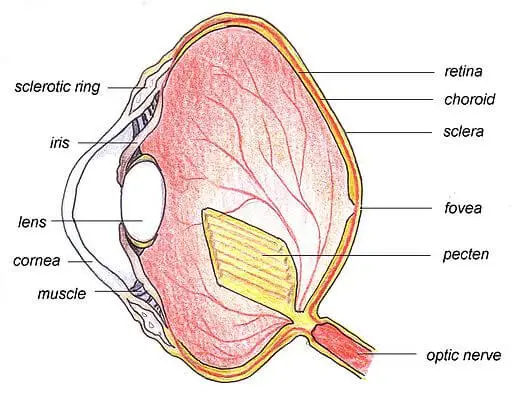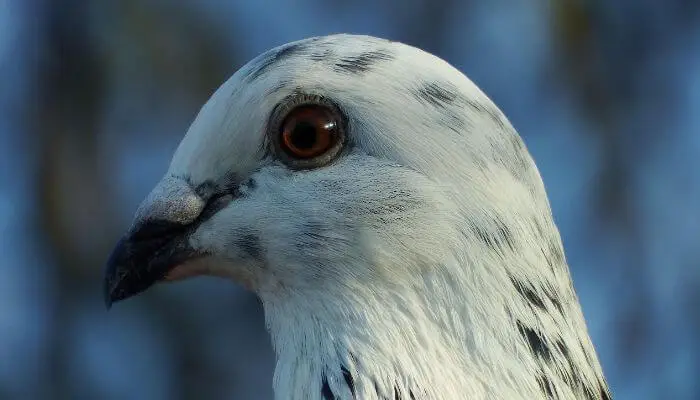When a pigeon fancier wants to identify a good pigeon they will have a set of criteria. Breeders too will look to enhance certain qualities.
When it comes to racing pigeons, the best breeds tend to be those described as high flyers. And what do racing pigeon fanciers look for in a champion? Surprisingly, it is the eyes.
There is great belief in the theory that you can see the qualities of a pigeon in its eyes. Whole books have been written about it.
The theory polarizes the racing pigeon community. Some truly believe the structure of a pigeon’s eye relates to the bird being a great racer or breeder or not. Others believe the theory to be foolish and invalid.
There is no real definitive scientific evidence to prove or disprove the theory so its validity and reliability is a matter of faith and preference.
Like the human eye, from the richness of color to the surface area to specific pigmentation, there is a lot to be evaluated in the eye of a pigeon.

The Pigeon Eye
Pigeons have very good eyesight with 340-degree vision.
Like many other bird species, the eyes are located laterally on the sides of the head, giving them binocular vision.
The structure of a pigeon’s eye (see below) is much the same as that of all avian species and is similar to the eyes of reptiles. Both groups’ eyes have ciliary muscles that enable the shape of the lens to change more rapidly and to a greater extent than the eyes of mammals.
The main difference between an avian eye and a mammalian eye is the shape. A mammal’s eye is spherical while a bird’s eye is flatter and elongated.

Pigeon Eye Sign Theory
The idea that the eye can point to a champion bird is based on “five circles”.
People who believe in the theory look at these five circles to find healthy signs and defects. The healthier the signs the better a bird will be while any with eye defects are usually left on the pigeon shelf.
The First Circle – pupil
The theory is that the size of a pigeon’s pupil is related to the nervous system, which in turn relates to the bird’s willpower.
In general, fanciers are told to avoid birds with particularly large pupils, as an increased pupil size has been directly related to a decrease in the ability to fly in difficult circumstances or conditions. The general consensus seems to be that champion flying birds do not have large pupils.
The idea is that pigeons who possess smaller pupils have greater willpower, as they do not change as much under different lighting settings which is a valuable benefit in the world of racing.
Ideally, pupils are intensely black and well-rounded.
The Second Circle – circle of adaptation
This is the ring that sits around the outer rim of the pupil. It differs in size and strength of color which may be any variation of black, grey or brown.
A strong circle of adaptation is broad, dark and deeply cut. This area is where the sphincter muscles which control the action of the pupil’s response to light are found.

The Third Circle – circle of correlation
The third circle is the ring between the circle of adaptation and the iris.
It is sometimes called the breeding circle.
The characteristics of import in the circle of correlation are color, lines and width.
Wider circles are preferable.
Any visible lines are known as distance lines. The longer the lines, the greater the propensity for long-distance flying (according to the theory).
Colorwise, there should be harmony with the other parts of the eye. It is most often various shades of brown and grey but sometimes it has a blue or yellow base color that shows through the entire eye’s upper layers.
Colors should be clearly defined and bright and not appear murky.
The Fourth Circle – Iris
The iris is the ring of color that can be found between the pupil and cornea.
You might also sometimes notice a thin black ring that separates the iris from the cornea. This ring is named after Louis Vermeyen, and the Vermeyen ring is always more noticeable in younger pigeons.
The iris comes in many different colors from light yellow, through red to a deep crimson.
Eye sign theory expresses a preference for richly colored irises over pallid irises.
The characteristics of the color are also important. The most desirable is described as being like moving volcanic lava with ridges, cuts and grooves.
The Fifth Circle – outer circle
Commonly black, the last circle may appear to be the same color as the adaptation circle or the color circle.
When there is over-pigmentation in the eye, a fifth circle may not be visible. This is a red flag to breeders and racing pigeon owners.

Other Eye Signs
Blood Supply
Blood supply to the eye impacts on the vision which will inevitably impact the performance of a pigeon.
The rate of blood supply to the eye is measured by looking at the amount of red color and granulation.
It gives a good indication of what the blood supply around the rest of the pigeon’s body is going to be like. When the blood supply to the eye is strong, it is a good indicator that the blood supply is strong elsewhere too.
Eye Changes
The color of the eyes might show signs of fading or dullness and this can be an indicator you have a stressed pigeon.
If the sparkle has disappeared, it can be a sign that the entire pigeon organism has been over-tired, leading to the blood supply dwindling to a minimum.
Pigeons who regularly show a dulling of their eyes are usually labeled as being unable to perform well enough to be of great racing stature.
The eyes of a healthy pigeon should be sparkling and glass-like. It will be rich in color and should be free of excessive fluid buildup. There should be no redness or damages/injuries within the eye and surrounding areas.
